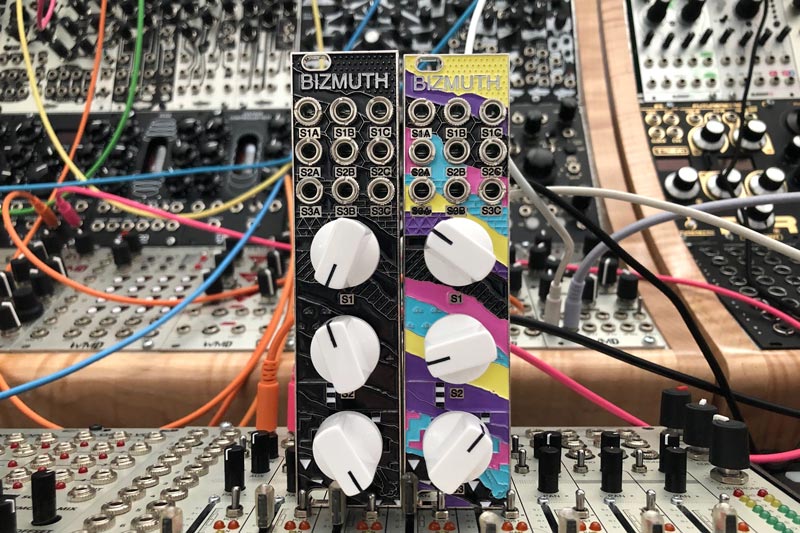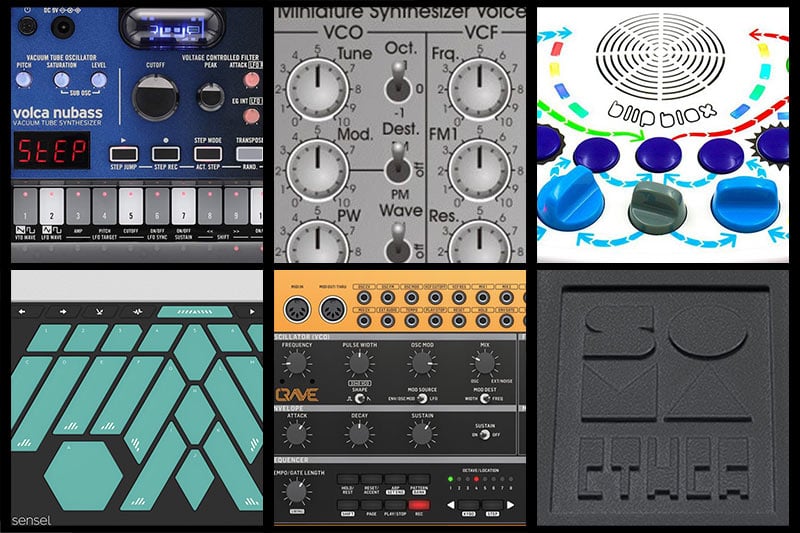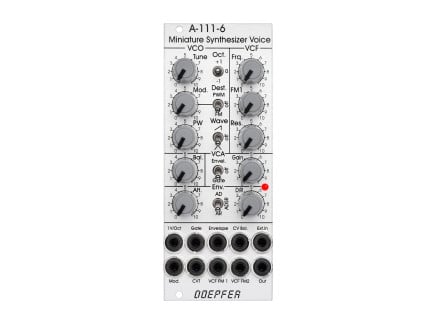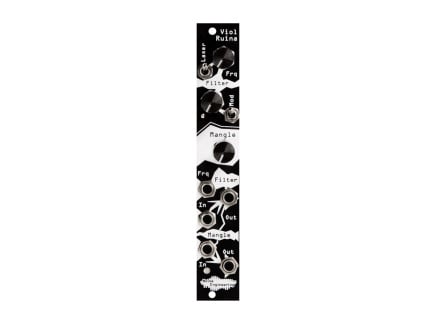2019 has seen the release of a lot of affordable, yet powerful tools for making electronic music. Music making should not be an elite, exclusive club—it should be accessible to everyone. This list presents some of the most interesting synthesizers of this year for more budget-minded musicians. While we're not in the business of picking the "best" synthesizer, the following synthesizers were some of the highlights of the year. Keep these in mind as the holiday season approaches...they just may make a good stocking stuffer for you or a friend!
Korg Volcas: Back and Better Than Ever
Korg delivers again with three more entries into the Volca line. This year saw the release of the Volca Drum, Volca NuBass, and the out-of-left-field Volca Modular. Korg has really found its groove with the Volcas, consistently coming out with solid products that don't break the bank and are as playable as they are portable.
Volca Modular is a semi-modular synthesizer that brings West Coast style synthesis in a Volca sized package. The patching is achieved with pin cables, similar to the ones used for breadboarding electronic components. The heart of the Volca Modular is a triangle core oscillator with wavefolding and FM. The FM is controlled by a modulation oscillator whose frequency can be set to be a ratio of the master oscillator. Other hallmarks of West Coast synthesis that appear on the Volca Modular are two function generators, clock divider, two low pass gates, and a random voltage source, called Woggle with stepped and smooth outputs. The Volca Modular has a powerful sequencer that can be quantized to scales including microtonal scales. Up to 16 sequences can be saved and recalled using the on-board memory. In Volca style, the knob positions can also be recorded into the sequences using the motion sequence function. On top of those functions a built-in reverb adds space and depth to the sounds. Volca Modular brings modular synth concepts to a remarkable price point, and is an absolute blast to play.
Volca NuBass is a tube-based bass synthesizer, which uses NuTube technology from Korg and Noritake Itron Corp. There are two tubes on the NuBass, one for the main oscillator and one for the saturation stage on the sub-oscillator. The main oscillator is a monophonic oscillator with saw and square waves as well as a sub-oscillator. The oscillator and sub-oscillator are routed through a transistor-ladder low pass filter. The filter has a large, playable frequency knob, resonance control, and dedicated A/R envelope. In addition to the saturation and filter, the NuBass has drive and tone control for harmonic shaping. The NuBass' LFO can be a triangle or square wave and the frequency goes into audio rate. The LFO has the ability to sync to the sequencer clock speed and can be assigned to modulate the amplifier, pitch, or cutoff. The sequencer has controls for slide, accent, and transposition. The randomize function can randomize any of these functions on the fly. Spiritual successor to the original Volca Bass, the NuBass is a monstrous bass machine at a great price.
Volca Drum is a new kind of drum machine. It organizes sounds into kits, which contain six sounds. Sounds are made up of two layers, which contain sound sources, a modulator, and an envelope. Sound sources include saw, sine, and filtered noise. The modulation section has the option for LFO, random, or envelope—meaning you can have mode than one envelope affecting your sound at the same time. The modulation goes up to audio rate and can be used for FM tones. The envelope can be linear, exponential, or double hit, which is great for making claps. The layered sound is sent to the waveguide, a Karplus-Strong style resonator that adds physical modeling-like effects to the sound. It can model either a string or a tube and has controls for pitch, decay, and body. The sequencer features a slice function which allows for ratcheting, up to 16 retriggered notes on a step as well as a randomize function. Volca Drum provides considerably more flexibility than many much more expensive drum machines, sounds great, and best of all—it's fun.
Sensel Morph: Dynamic Touch Controller
Sensel Morph is a versatile touch controller, with the ability to change functionality just by swapping silicone overlays. The interchangeable surfaces include piano, drum, video editing, gaming, drawing, even a Buchla Thunder-style overlay, licensed from Buchla USA. The piano overlay features a two-octave keyboard, with the ability to add vibrato by moving your fingers side-to-side. The drum overlay features 13 drum pad locations and supports finger drumming or playing with sticks. The music production overlay features 16 pads, one octave of mini piano buttons, two sliders, and eight touch knobs. The Buchla Thunder overlay is based off of the cult classic Thunder MIDI controller, and is perfect for MIDI Polyphonic Expression. MPE allows for polyphonic transmission of MIDI messages such as pitch-bend or velocity.
The Morph is velocity-sensitive and features 20,000 pressure sensors, with an input range of one gram to five kilograms. Additionally, it features 6502 dpi tracking with speeds of 125Hz at full resolution mode at with eight ms latency, or 500Hz with two ms latency in high speed mode. Connect the Morph to your computer or mobile device using Bluetooth or USB. The really great part of the Sensel morph is that it does not constrain you to one controller type, the swappable overlays allow you to have many controllers. It is worth noting that the Buchla Thunder overlay pushes the price up to $269, but the functionality included justifies the price increase.
SOMA ETHER: A N T I - R A D I O
The SOMA ETHER is in essence an anti-radio. Instead of being tuned to a certain band, it lets through all the noise, interference, and radiation from hertz to gigahertz that a normal radio blocks out. It captures the invisible electromagnetic fields that surround us every day and takes inspiration from the earliest radios. These early radios didn't have a tuning wheel because there were few radio stations and what little did exist used morse code. The timbre, or "voice" of each of the transmitters was able to be distinguished by ear.
ETHER has both electrical and magnetic components that sense radiation. The magnetic component has a magnetic antenna, similar to the ones used on old long-wave radios. The sounds generated by the magnetic antenna can be manipulated by changing the position and rotation of ETHER. The electric components are an antenna printed on the PCB and the two contact points on the top of the unit. These allow anything conductive to be turned into an antenna. This includes light poles, fences, or even your own body. ETHER also features a control for the high-frequency gain which allows you to pick out different dynamic levels contained in the surrounding electromagnetic landscape. ETHER is a tool for the exploration of the invisible world that surrounds us.
Doepfer A-111-6 Synthesizer Voice
Doepfer A-111-6 is a whole synthesizer voice in one 10hp package with VCO, VCF, VCA, envelope, and balance unit. The VCO is a triangle-core wave VCO with pulse, saw, and triangle wave outputs. The tuning can be set manually via knob and octave switch and has a range of about 32Hz to 16kHz, with precise 1 v/oct tracking up to about 4kHz. The VCO features mod input with attenuator and destination switch, which can be set to pulse width or frequency modulation. The balance circuit is comprised of two VCAs, which are controlled by the sum of the balance control and CV in the opposite direction. VCA 1 is hardwired to the VCO's output and a sub-octave, a rectangle wave that runs at half the frequency of the VCO is normalized to the VCA2 of the balance unit. Patching into the Ext in breaks this normalization. The output of the balance is sent into the VCF.
The VCF is a 24dB low pass filter with frequency and resonance controls that go to self-oscillation. The VCF has two CV inputs, one with CV attenuator, and one that is used for 1 v/oct control of the VCF frequency. The VCF tracks better than your average filter, but not as good as the VCO. The envelope can be used in A/D, ADSR, and A/R modes, and has control for attack and decay/release. A CV input for the envelope is available and can be assigned via jumper to control the A or D/R, and if positive voltage shortens or lengthens the envelope time. The envelope is routed to the VCA which controls the final audio output from the A-111-6. All of those features are packed into a small size that doesn't feel cramped. Doepfer really hit it out of the park on this one—providing an entire, high-quality synth voice at a remarkable price and size.
Noise Engineering's Distortion of the Month
Noise Engineering decided to make 2019 the year of distortion, with their distortion of the month line. 2019 has seen five distortions so far, all under $200. Noise Engineering is known for their in-your-face sound, but are usually associated with digital modules. The distortion modules are analog, and each provide a different flavor of tonal shaping to your Eurorack system.
Terci Ruina gives you three classic analog distortions; transistor feedback, feed-forward diode clipper, and transistor fuzz. The TR has inputs and outputs for each channel, but the output of each channel cascades into the input of the next channel. It adds a lot of grit and is not for users looking for "pretty" distortion.
Kith Ruina takes inspiration from the world of guitar amps. It features a classic workflow, a one knob drive circuit into a two band EQ. The EQ has control for high and low bands, with boost to the right and cut to the left side of the knob, as well as a switch for the mid range. The KR features inputs for the drive and tone, with the output of the drive normalized into the input of the tone. While it's origins are in the realm of guitar amps, it's equally suited to be used with modular gear.
The Viol Ruina is an analog lowpass filter and distortion with envelope follower and self-modulating cutoff. It features controls for frequency, resonance, and mangle distortion, with CV control over frequency. The laser switch engages the envelope follower and the mod switch routes the audio back into the frequency control for input-dependent FM. Both switches feature three modes, off, mild, and high. The output of the filter is normalized into the input of the mangle distortion, but this normalization is broken with something patched into the mangle. While Viol Ruina is a filter, it offers so much more in terms of tone shaping than your vanilla Eurorack low pass filter.
Seca Ruina is a multi-band distortion that divides the incoming audio into three frequency bands. The three bands each have their own drive control. Additionally, each band has its own CV input, plus a CV input for all the bands. Each band has its own separate output, which allows for further processing of the split audio. In addition to the individual outputs, there is a mix output with a VCA for controlling the level. Seca Ruina is great for taking one input source and dynamically animating it.
The Pura Ruina is a three-stage CV controlled full-wave rectifier. Full wave rectification takes the negative-going portion of a waveform and folds it over to the positive portion, effectively doubling the frequency and adding complex harmonics. It has four knobs, labeled one, two, four, and eight. One is the dry signal, two is the rectification of the signal, four is a double-full-wave rectifier, and eight is a triple-full-wave rectifier. There are CV inputs for every stage, plus an All CV input. Every stage has its own output, or there's a sum output. Pura Ruina is a unique take on distortion and adds a different flavor of harmonic content to your setup.
Behringer's Crave: Not a Clone(!?)
The Behringer Crave is a semi-modular desktop analog synthesizer that takes inspiration from a few sources, while providing its own identity. The VCO based on the 3340 IC found in the Prophet-5 and features saw and pulse outputs, with adjustable pulse width. There is robust internal modulation routing that forgoes the need for patch cables, although you can repatch and reconfigure the Crave to provide a multitude of functions. Internal routing takes both the envelope and LFO and routes them both into the VCO mod and VCF mod. Both modulation destinations have modulation attenuators. The VCO mod can affect pulse width or frequency and the VCF mod can affect the VCF either positively or negatively. The envelope can be two or four stage, with sustain on or off. In four-stage mode, the decay controls both decay and release.
The analog LFO goes into audio rate and features a CV input, a feature not usually found on these compact monosynths. The Crave features a mixer, which mixes between the VCO and either noise or an external input. An old trick that originated in Moog monosynths is to take the output of the filter and route it through the external input for additional distortion. The filter is a 24 ladder filter, the same as the one found in the Behringer Model-D with both low pass and high pass modes. The resonance self-oscillates and can be played as another oscillator.
Crave features both a sequencer and arpeggiator. The arpeggiator can be momentary or latching, with eight patterns available, including random mode. The sequencer can create patterns up to 32 steps and can save and recall up to 64 patterns. The sequencer has per step control of gate length, glide, ratchet, accent, and rest. One hidden feature that's not immediately apparent is the assignable output. The assignable output can serve a variety of functions including tempo synced LFO, sample and hold, clock division of the sequencer, or MIDI messages. The top of Crave features the powerful 18 in/14 out patch matrix, which can be used to override the internal modulation routing. Crave also features MIDI in and through, as well as MIDI over USB. The USB connection can be used to change parameters on Crave using an app from Behringer. While part of the new line of inexpensive analog synthesizers from Behringer, Crave is its own beast, a breath of fresh air in a world of clones—at at this price, it's a spectacular choice of synth for beginners looking to start discovering the world of analog synthesis.
Blipblox: A Synthesizer for Kids
Playtime Engineering Blipblox is a synthesizer made for kids of all ages, meant to provide hours of fun without needing to know exactly what it does. It features many of the typical building blocks of synthesis: an oscillator, sequencer, filter, amplifier, two LFOs, and two envelopes. The Blopblox's signal flow starts with the sequencer.
The large lever controls the speed of the sequencer, but instead of programming the sequencer, you press a button to randomly select one of the hundreds of Blipblox's patterns. The sequence then goes to the oscillator. The oscillator is a digital oscillator with eight different modulation types. These include PWM, sync, and FM. The oscillator is then passed into the filter, whose cutoff frequency is controlled by the other large lever. The filter is a non-resonant low pass filter. After the filter, the sound is passed into an amplifier, which is modulated by a release-only envelope.
The Blipblox features a 3x3 modulation matrix, with three sources and three destinations. The modulation sources are two LFOs and an attack only envelope. These can be routed into the two oscillator modulation destinations or the filter cutoff. The grey knobs control the frequency of the LFOs and envelope attack, and the blue knobs are attenuators that control the amount of modulation. There are two additional buttons that affect the sound. The randomizer button will randomize the sound settings but not the sequencer. The sound freak button activates a momentary glitchy mode, reminiscent of circuit bent toys. The Blipbox also features a kick and snare, with buttons and a drum sequencer. The drum sequencer is turned on and off whenever a new sequence is selected.
The Blipblox has controls that are suited for small hands and an inviting layout. It's much more than the standard kids keyboard: it's an actual musical instrument that provides hours of endless exploration. So if you're looking for a way to bond with your kids or looking for an out-there soundmaker, Blipblox just might be the perfect thing.
Endorphin.es: Powerful, Digital, 6hp
Endorphin.es came out this year with a line of 6hp modules that provide a lot of functionality in a small package.
Endorphin.es Milky Way Stereo Effects is stereo multi-effects module with 16 different effects, organized into two banks of eight, airways bank and darkwaves bank.The Milky Way features 48kHz 16-bit audio quality and can be used in mono or stereo; with input one normalized into input two. The Cabin Fever knob controls the two parameters of each effect, with the ability to switch between primary and secondary controls. The reverb effects range from plate to room to hall, creating reverberant spaces in a wide range of sizes. Other effects include multiple delays (including ping-pong and tape echo), chorus, flanger, ring mod, compressor, overdrive, and freezer/looper. With the press of the tap and type, the Meta FX scanning becomes active, with ability to scan through the active effect, either manually or under CV. The Milky Way also features a final output volume knob and an internal VCA. The Milky Way provides straight-forward and easy to use effects that makes a great addition to any Eurorack system.
Squawk Dirty to Me Dual Filter is a stereo digital multi-mode filter. It features 48kHz 16-bit audio quality and eight filter modes. Filters include Moog style transistor ladder, Korg MS-20 style with screaming resonance, resonant and non-resonant low pass gates, DJ isolator-style filter, state variable high pass and bandpass, and a comb filter. The filter types can be manually changed or selected under CV in meta mode. Squawk also features a non-resonant high pass filter that comes before the primary filter in the signal chain, in order to cut down on some of the lower end frequencies. After passing through both filters, the final output is passed through a VCA. Squawk can be used in mono or stereo, with input one normalized to input two. While any one of those filter types would make a great filter module, the ability to select or scan between them on the fly adds a new realm of playability not found on most Eurorack filters.
Airstreamer Envelope is an envelope generator with both unipolar and bipolar outputs. It is digital and features 224kHz sample rate and zero aliasing. There are three modes, LFO/VCO, attack/sustain/release, and attack/decay, called transient. The two main controls are rise/attack and fall/decay. These control the time it takes for the signal to reach its highest point and then the time it takes to return to the starting level. These two controls have independent shape control which doesn't change the timing, but changes the shape of the slope of the signal. When a CV signal is present at the CV inputs, the corresponding shape control becomes an attenuverter for the incoming CV. In addition to the rise and fall CV inputs, the Airstreamer features an exponential 1V/Oct input when the module is cycling.
In A/D and A/S/R mode the 1V/Oct input becomes a slew input. The Airstreamer can also act as a track and hold or sample and hold in conjunction with the 1V/Oct input when not looping. The end of stage(s) output can be changed to be either end of attack trigger output or an end of cycle gate output, depending on the jumper settings on the back of the module. The output of the Airstreamer goes into a thru-zero VCA. The thru-zero VCA inverts the envelopes when the modulation source goes into negative voltages. This affects both the unipolar and bipolar outputs. The Airstreamer is a great little function generator, capable of many more things that you would think from its small size and panel layout.
Honorable Mentions
The instruments made by Rucci Electronics are fun and accessible. They range from simple noise boxes to complex sequencers with wide selection of modules in-between. Modules are housed in stomp-box styles enclosures that are rather spartan in their design, but beautiful in their own right. An entire article could be devoted to the Rucci instruments, but that is for another day.
Dnipro Modular Metamorph is controller/sequencer takes inspiration from the Serge concept of preset sequencing: using a sequencer-like "programmer" to alter many parameters at once. It features three channels, each with a four-step sequencer with glide. The active step can be clocked or addressed using the four buttons/gate inputs or CV input. Two Metamorphs can be linked together to create eight step sequences.
Steppy is a four-track programmable gate sequencer. Each track can have its own step length, gate length, clock division, swing, delay, and probability. Steps can be tapped in or entered in a classic step sequencer fashion. Steppy features eight internal presets that can be saved and recalled on the fly. Steppy is also available as a 1u module, in the Intellijel style of 1u modules.
 Both versions of the Bizmuth side by side
Both versions of the Bizmuth side by side
The Bizmuth Modular Bizmuth is a chaotic bi-directional signal router. It features three knobs which are used to route up to six external signals, or generate up to six gates. As a knob is turned, the corresponding switch advances to form a new routing configuration. In a full 360 degree rotation, over which the connection sequence repeats 24 times. The jacks are all bi-directional, meaning they can act as inputs or outputs. The Bizmuth is very expressive and gestural, able to make sweeping changes with even small turns on the dial.
Befaco's Kickall is much more than a bass drum module. It features the component parts that one might use to patch up to create a bass drum in a Eurorack module, VCO, VCA, envelope, and wave shaper. The waveform goes from a clean sine wave to a square wave, controlled by the prominent knob. The accent input adds an additional VCA that can be used to augment the functionality of the Kickall and all of the controls have CV inputs.
These are just some of the offerings of 2019. There was a wide range of new instruments from esoteric tools for sonic explorations to straight-ahead mono synths—2019 had it all. These may be a great addition to your already developed studio, or could be used to start a fledgling hardware setup. Looking forward to 2020, we expect to see even more awesome instruments in this price range.




















